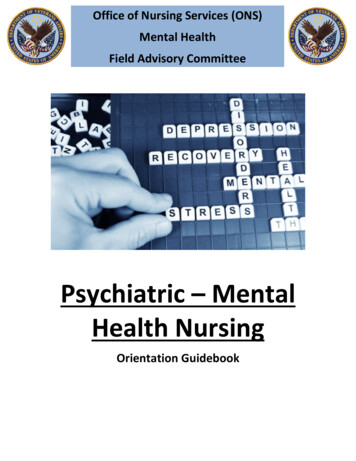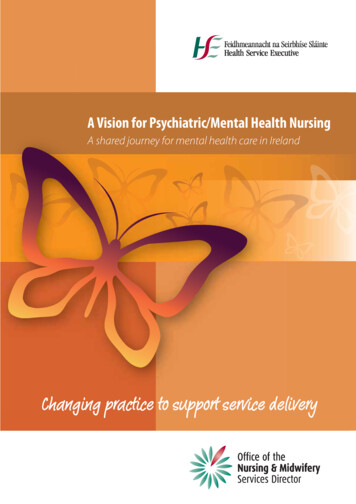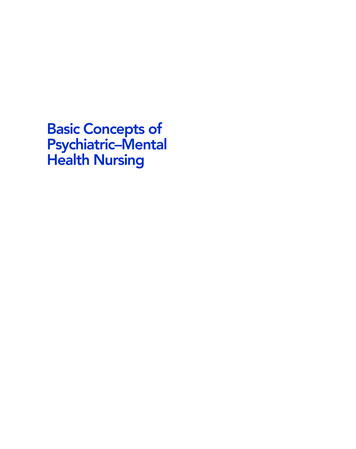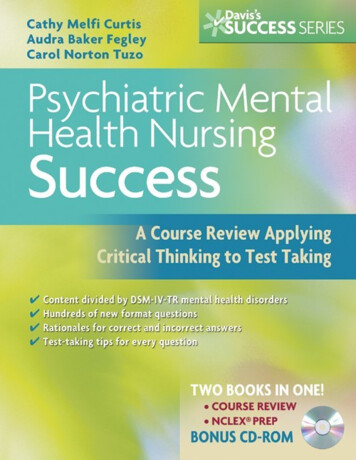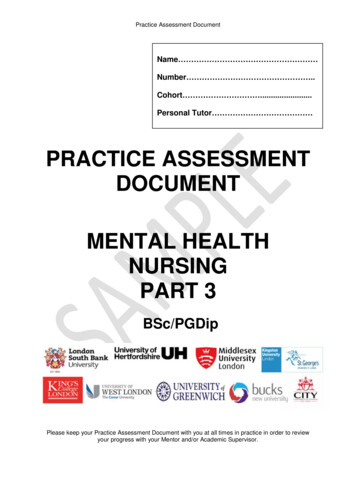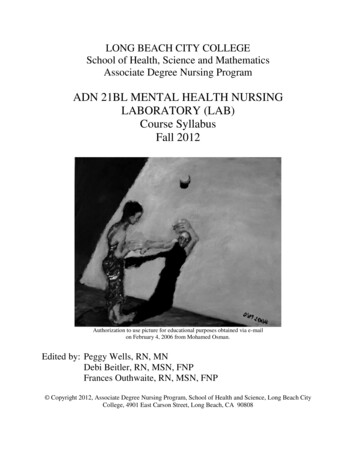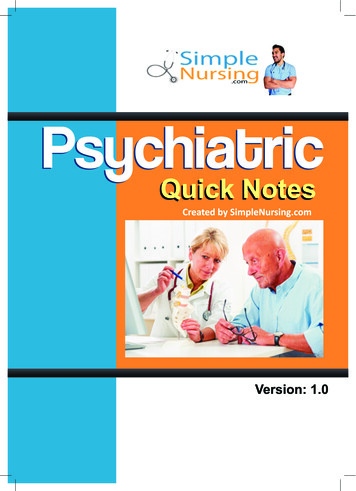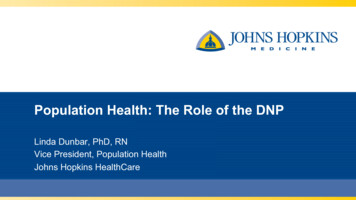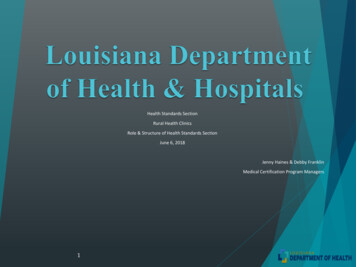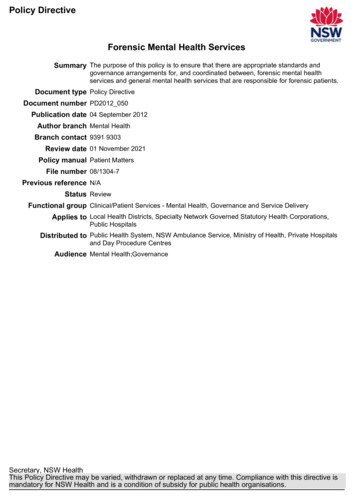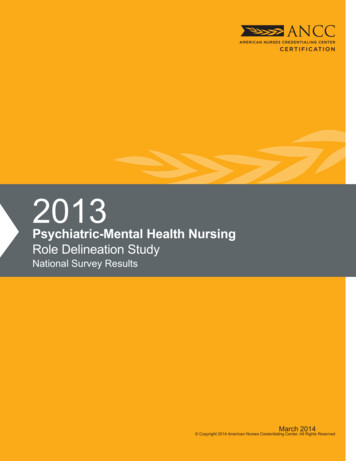
Transcription
2013Psychiatric-Mental Health NursingRole Delineation StudyNational Survey ResultsMarch 2014 Copyright 2014 American Nurses Credentialing Center, All Rights Reserved
About this ReportThis report pertaining to the practice of Psychiatric-Mental Health nursing was based onthe results of a 2013 national study of psychiatric-mental health, medical-surgical, pediatric,gerontological, and cardiac-vascular nursing practice.2013 Role Delineation Study: Psychiatric-Mental Health NursingNational Survey Results Copyright 2014 American Nurses Credentialing Center, All Rights Reserved
Table of ContentsACKNOWLEDGEMENTS. 3BACKGROUND . 4ROLE DELINEATION STUDY OVERVIEW . 4UPDATED TEST CONTENT OUTLINES . 4ROLE OF THE CONTENT EXPERT PANELS . 4SURVEY METHODOLOGY . 5SURVEY CHRONOLOGY . 5SAMPLE SELECTION. 5SURVEY DEVELOPMENT AND MEASURES . 6DATA COLLECTION . 7DATA ANALYSIS . 7SURVEY RESULTS. 10DEMOGRAPHIC INFORMATION . 10PRACTICE DESCRIPTIONS. 11APPENDICIESWORK ACTITIVIES STATEMENTS . APPENDIX ADEMOGRAPHIC DATA SUMMARY . APPENDIX BWORK ACTIVITIES DESCRIPTIVE STATISTICS . APPENDIX CWORK ACTIVITIES MEAN OVERALL CRITICALITY -- RANK ORDER. APPENDIX D2013 Role Delineation Study: Psychiatric-Mental Health NursingNational Survey Results Copyright 2014 American Nurses Credentialing Center, All Rights Reserved2
AcknowledgementsThe American Nurses Credentialing Center (ANCC) wishes to thank a number ofcontent experts who served on the 2013 Psychiatric-Mental Health Nursing Role DelineationStudy panel for sustaining this effort and producing a role delineation study of such high caliber.Without their numerous hours of input and feedback, the study would not be possible.We also would like to thank the ANCC staff who also spent numerous hours working tomake this study possible: Christine DePascale, MS (Project Manager)David Paulson, PhD, CAEChie Ohba, PhDGossie NworuFinally, we would like to thank the ANCC-certified psychiatric-mental health nurses whosupported this study by completing the survey questionnaire.The contributions that all of these people made to the study were essential to its success.2013 Role Delineation Study: Psychiatric-Mental Health NursingNational Survey Results Copyright 2014 American Nurses Credentialing Center, All Rights Reserved3
BackgroundThe American Nurses Credentialing Center (ANCC), which was incorporated in 1991 asa subsidiary of the American Nurses Association, is the largest nursing credentialing organizationin the United States. Its vision is to drive nursing excellence, quality care and improvedoutcomes. Currently, ANCC offers 25 examinations at various levels including diploma andassociate degree, baccalaureate, and advanced practice for nurse practitioners, clinical nursespecialists, and other disciplines. More than 19,000 candidates took an ANCC certificationexamination in 2013. In addition to certification, ANCC provides services such as the Magnet andPathways to Excellence recognition programs for hospitals and other facilities that demonstrateexcellence in nursing services, accreditation of continuing education programs, education andconsultation services, and outreach to nursing organizations around the globe.Role Delineation Study OverviewRole delineation or job analysis studies are typically carried out at the national level withthe goal of describing current practice expectations, performance requirements, andenvironments. ANCC has a current goal of conducting a study of each specialty approximatelyevery three years in order to capture changes in work activities and the knowledge and skill areasrequired to perform those activities. The findings are used to update the content of its respectivecertification examinations.The 2013 Role Delineation Study for Psychiatric-Mental Health, Medical-Surgical,Pediatric, Gerontological, and Cardiac-Vascular Nursing involved two sets of processes oractivities that ran more or less concurrently: a national web-based survey and a linking activity.The national survey was designed to collect information on the work activities nurses actuallyperform in practice, while the linking activity identifies the major knowledge and skill areasrequired to perform the work activities listed in the survey. The results of both of these processeswere used in the updating of the test content outlines for each examination contained within thestudy.Updated Test Content OutlinesThe results of this role delineation study were used for updating the test content outlinefor the ANCC Psychiatric-Mental Health Nursing Board Certification Examination. Examinationforms produced based on the Psychiatric-Mental Health Nursing Test Content Outline developedthrough this study are scheduled to go into effect October 25, 2014. A copy of the test contentoutline is available on the American Nurses Credentialing Center website.Role of the Content Expert PanelsThroughout the study, ANCC invited professionals in practice and educators who teachcourses relevant to the nursing specialties included in this study to serve on specialty specificcontent expert panel. They developed the work activities and demographic items for the survey,linked knowledge and skill areas to the work activities list, and finalized the test content outlinesfor the certification examinations. All of the content experts serving on the panels were certifiedby ANCC in the nursing specialty they represented and were invited to serve on the panel basedupon their expertise in the specialty.2013 Role Delineation Study: Psychiatric-Mental Health NursingNational Survey Results Copyright 2014 American Nurses Credentialing Center, All Rights Reserved4
Survey MethodologyThe purpose of the development and administration of the national survey was to collectinformation on the work activities nurses within the specified specialties perform in practice. Therole delineation study panel met for three days beginning February 11, 2013 to draft a pilotversion of the survey and to construct the initial map of knowledge and skill areas relevant to thework activities included in the survey.Survey ChronologyThe survey development and administration timeline was as follows:February – April 2013 The role delineation study panel along with staff from ANCC drafted the survey. The survey was pilot tested and revised.May – June 2013 The final survey was administered on the web.August – September 2013 The survey activity results were analyzed, and activity weights were determined. Each panel met to review the survey results and activity weights.Sample SelectionIn February, there were a total of 8,585 actively ANCC-certified Psychiatric-Mental HealthNurses. A random sample of 1,500 nurses ANCC board certified in Psychiatric-Mental HealthNursing, stratified by region, was selected from the ANCC certification database to participate inthe national survey. An additional 25 were randomly selected to participate in the pilot survey.Table 1 presents the ANCC-certified Psychiatric-Mental Health nurses selected to participate inthe national survey from each region.Table 1. Number of ANCC-certified Psychiatric-Mental Health Nurses Selected per Geographic RegionGeographic RegionNortheast – NY, CT, MA, NJ, ME, PA, NH, VT, RISouth – TN, MS, TX, FL, LA, AL, GA, AR, OK, VA, MD, SC, DC, NC, WV, DE, KYMidwest – IA, NE, KS, OH, MO, MN, SD, ND, MI, IL, IN, WIWest – WA, AZ, CA, OR, CO, AK, ID, NM, UT, HI, NV, WY, MTOther – AE, AP, APOTotal2013 Role Delineation Study: Psychiatric-Mental Health NursingNational Survey Results Copyright 2014 American Nurses Credentialing Center, All Rights ReservedNumber of Selected 5
Survey Development and MeasuresStarting on February 11, 2013 the role delineation study panel met in Silver Spring, MD todraft the national 2013 Role Delineation Study for Psychiatric-Mental Health, Medical-Surgical,Pediatric, Gerontological, and Cardiac-Vascular Nursing survey. The panel members reviewedand discussed the work activities which had been used in the ANCC's 2010 Role DelineationSurvey of Five Nursing Specialties – Cardiac-Vascular, Medical-Surgical, Gerontological,Pediatric, and Psychiatric-Mental Health Nursing as well as the following American NursesAssociation (ANA) scopes and standards: Nursing: Scope and Standards of Practice: Nursing (2010) Psychiatric-Mental Health Nursing: Scope and Standards of Practice (2013 draft) Pediatric Nursing: Scope and Standards of Practice (2008) Gerontological Nursing: Scope and Standards of Practice (2010) Cardiovascular Nursing: Scope and Standards of Practice (2008)They updated the work activity list to reflect current practice of nursing within the five specialties.As a result of this meeting, the panel reached consensus on a list of 65 work activities to be usedin the 2013 survey. These work activities were divided into 8 domains: Assessment andDiagnosis; Planning and Outcomes Identification; Implementation; Evaluation; Nurse-PatientRelationship; Patient Education; Leadership; and Population Health. The complete text of thework activities list is presented in Appendix A. The workgroup also identified and finalized a setof 15 demographic questions. (See Appendix B.)During the same meeting, the workgroup reviewed and approved three scales thatrespondents would use to rate the work activities listed in the survey — Frequency (the frequencywith which a work activity is performed), Performance Expectation (how soon on the job theperformance of a work activity is expected), and Consequence (the consequence of performing awork activity incorrectly). The performance expectation scale was specifically designed todistinguish entry-level skills. These three questions and the instructions for answering them arepresented in Table 2.Table 2. Survey Questions for Rating Work Activity StatementsPerformance Expectation: When is a newly certified specialty nurse first expected to perform this activity?-- Within the first 6 months of certification within the specialty.-- After the first 6 months of certification within the specialty.-- Never expected to perform this activity within the specialty.Frequency: How often does a newly certified specialty nurse perform this activity (consider within a one year period)?-- Always-- Frequently-- Occasionally-- Seldom-- NeverConsequences: Does incorrect performance of this activity cause:-- No negative consequences.-- Mild negative consequences.-- Moderate negative consequences.-- Severe negative consequencesThe study design included combining each respondent’s responses to each of the threerating scales in a hierarchical manner into one overall ranking of criticality. To select a procedurefor combining the three scales, importance of each scale to the performance of the work activitywas considered. Performance expectation scale was determined to be regarded as more criticalthan the other two scales for representing entry-level practice. The consequence scale was then2013 Role Delineation Study: Psychiatric-Mental Health NursingNational Survey Results Copyright 2014 American Nurses Credentialing Center, All Rights Reserved6
regarded as more critical than the frequency scale. Therefore, the scales were combined so thata particular value on the performance expectation scale would outweigh or outrank all values onthe consequence and frequency scales. This hierarchical scheme emphasized the work activitiesthat are required of newly certified specialists and have the greatest impact on public health orsafety. Thus this scheme was selected as the organizing mechanism for combining theresponses from the three survey scales into an overall measure of criticality.Data CollectionPilot Testing. Using the same procedures intended for administering the national datacollection, the survey was piloted in March and April 2013. Twenty-five ANCC-certifiedPsychiatric-Mental Health nurses were included in the selection of 125 ANCC-certified nursesrandomly selected from across the nation to take the pilot survey. Overall, 42 (34 percent) of thenurses invited to take the pilot survey responded (7 psychiatric-mental health nurses).National Survey. In May and June 2013, the 1,500 ANCC-certified Psychiatric-MentalHealth nurses selected to take the national web-based survey were sent three notifications viathe United States Postal Service: an alert letter, and two follow-up reminders. The alert letterexplained the purpose and importance of the study, the eligibility criteria of the study, and statedhow to access the survey via the internet. The letter indicated that the participant’s responseswould be kept confidential.The letter also notified that respondents completing the survey receive a 5 hour reductionof their continuing education requirement for their ANCC recertification.The first follow-up reminder letter was sent approximately two-weeks after the alert letter.It thanked recipients if they had already submitted their completed survey and encouraged themto do so if they had not already.The final follow-up reminder letter was sent out only to those who had not yet respondedto the survey and was sent out approximately two-weeks prior to the end of the survey.Data AnalysisThe three rating scales were combined into a single measure of overall criticality using ahierarchical method. As agreed by the initial study workgroup, the three rating scales werecombined into a single measure in such a manner that a particular value on the performanceexpectation scale would outweigh or outrank all values on the consequence and frequencyscales, and that a particular value on the consequence scale would outweigh or outrank all valueson the frequency scale.Table 3 displays how the values of the overall criticality rating were constructed accordingto all the possible survey response patterns that might be given to rate an individual work activityby its frequency, performance expectation, and consequence. For example, if a respondentindicated that a particular work activity was expected to be performed within the first six months ofwithin the specialty, could cause severe negative consequences if it was performed incorrectly,and is performed occasionally, the overall criticality rating for that response pattern would be 39.A score of 32 suggests that a work activity is generally expected to be performed within the firstsix months of certification within the specialty and have moderate negative consequences ifincorrectly performed. Therefore, work activities with scores of 32 or higher on the overallcriticality variable may be considered as highly critical. When a work activity was rated as neverexpected on the performance expectation scale, it would receive an overall criticality score of 1 asthe bottom row in Table 3 indicates.2013 Role Delineation Study: Psychiatric-Mental Health NursingNational Survey Results Copyright 2014 American Nurses Credentialing Center, All Rights Reserved7
Table 3. Construction of the Overall Criticality VariableSurvey Response OptionsPerformance ExpectationsConsequencesWithin the first 6 months ofcertification within the specialtySevere negativeconsequencesModerate negativeconsequencesMild negativeconsequencesNo negativeconsequencesAfter the first 6 months of certificationwithin the specialtySevere negativeconsequencesModerate negativeconsequencesMild ways11Frequently10Occasionally9Seldom8Never72013 Role Delineation Study: Psychiatric-Mental Health NursingNational Survey Results Copyright 2014 American Nurses Credentialing Center, All Rights Reserved8
Table 3. Construction of the Overall Criticality Variable (Continued)Survey Response OptionsPerformance ExpectationsAfter the first 6 months of certificationwithin the specialty (Continued)ConsequencesNo ver expected to perform thisactivity within the specialty2013 Role Delineation Study: Psychiatric-Mental Health NursingNational Survey Results Copyright 2014 American Nurses Credentialing Center, All Rights Reserved19
Survey ResultsThe total sample size of the national survey included 1,500 ANCC-certified PsychiatricMental Health nurses. A total of 484 completed surveys were returned. Forty (40) respondentsindicated they were not currently practicing in Psychiatric-Mental Health nursing for an overallresponse rate of 32 percent and a usable response rate of 30 percent.Table 4 shows the percent of surveys per population returned in each geographic regioncompared to the number of ANCC-certified Psychiatric-Mental Health nurses selected within theregion.Table 4. Number of Surveys Returned per Geographic RegionGeographic RegionNortheast – NY, CT, MA, NJ, ME, PA, NH, VT, RISouth – TN, MS, TX, FL, LA, AL, GA, AR, OK, VA, MD, SC, DC, NC, WV,DE, KYMidwest – IA, NE, KS, OH, MO, MN, SD, ND, MI, IL, IN, WIWest – WA, AZ, CA, OR, CO, AK, ID, NM, UT, HI, NV, WY, MTOther – AE, AP, APOTotalNumber Selected(Percent of total pop.)Number Returned(percent of total pop.)464 (30.93)142 (31.98)477 (31.80)149 (33.56)326 (21.73)95 (21.40)232 (15.47)58 (13.06)1 (.07)0 (0)1,500 (100.00)444 (100.00)Demographic InformationAppendix B details the Psychiatric-Mental Health nurses responses to 15 demographicquestions which included inquiry on the respondent’s background and practice setting.Demographic BackgroundApproximately 89 percent of the respondents were female and 82 percent reported to bewhite. Approximately 78 percent of the overall sample fell into the age group of 45 to 64 years ofage.Approximately 45 percent of the Psychiatric-Mental Health nurses indicated that theirentry-level (initial) education in Nursing was through an Associate Degree in Nursing programand 29 percent indicated it was through a Baccalaureate in Nursing program. Thirty five percentof the Psychiatric-Mental Health nurses indicated that they held a Baccalaureate in Nursing astheir highest degree in nursing. Approximately 28 percent indicated that they held an AssociateDegree in Nursing as their highest nursing degree and 17 percent of the respondents indicatedthat they held a Masters in Nursing.The average number of years of experience the Psychiatric-Mental Health nurses had asan RN was 26 years. The respondents also reported on average 22 years of experience workingwithin the specialty.Thirty six percent of the respondents indicated working as a Staff Nurse (includingcommunity, clinic, in-patient/client, or other setting, 16 percent indicated working as a ChargeNurse, and almost 16 percent indicated working in management.2013 Role Delineation Study: Psychiatric-Mental Health NursingNational Survey Results Copyright 2014 American Nurses Credentialing Center, All Rights Reserved10
Practice SettingsApproximately 45 percent of the Psychiatric-Mental Health nurses indicated that theypracticed in cities with populations between 50,000 and 249,999. Towns with a populationbetween 2,500-49,999 had the second highest percent of respondents (21 percent) andMetropolitan areas with a population between 250,000 and 999,999 had the third highest percentof respondents (15 percent).In terms of practice setting, approximately 67 percent of the Psychiatric-Mental Healthnurses indicated that they practice in a Psychiatric/Mental Health Facility. Seventy eight percentof the respondents indicated they care for patients with Psychiatric conditions while 8 percentindicated caring for patients with Acute conditions. The Psychiatric-Mental Health nursesreported spending a vast majority of their time treating Adult and Older Adult patients ages 18years and older.Practice DescriptionsDescriptive statistics (means, standard deviations, and medians) for the three ratings ofall 65 work activities—performance expectation, consequence, and frequency—and mean overallcriticality are listed in Appendix C. The scales were highly reliable. Cronbach’s coefficient alphaestimates for the performance expectation, consequence, and frequency scales when applied toall the data were 0.9443, 0.9858, and 0.9570, respectively. (Cronbach's coefficient alpha, ameasure of internal stability, ranges in value between 0 and 1.)In Appendix D, the overall criticality statistics are presented in rank order of criticality.As indicated in Table 5, 19 work activities were rated by the 444 respondents as highly critical(with a mean overall criticality rank of 32 or above).Table 5. Number of Work Activities by Mean Overall Criticality Range and Population for Psychiatric-Mental Health NursingMean Overall Criticality ScoreNumber ofWorkActivities37.0 andaboveBetween32.0 and36.9Between27.0 and31.9Between22.0 and26.9Between17.0 and21.9Between12.0 and16.9Between7.0 and11.96.9 andunderTotalnumberabove32.0217247690019Table 6 and 7 displays the 20 highest-ranking and the 20 lowest-ranking work activitiesby mean overall criticality respectively. The grey shading in Table 6 highlights the only workactivity that received a criticality rating of 37 and above. Activity 21. Administer medications andother treatments that are appropriate to the patient situation, received the highest ranking of38.59. However, in Table 7, activity Participate in the development of new approaches for caredelivery that promote population health received the lowest ranking of 12.922013 Role Delineation Study: Psychiatric-Mental Health NursingNational Survey Results Copyright 2014 American Nurses Credentialing Center, All Rights Reserved11
Table 6. Top 20 Work Activities Ranked by Mean Overall CriticalityWork Activity Number and r medications and other treatments that are appropriate to thepatient situation.Maintain appropriate physical and emotional boundaries.Obtain a current medication and treatment list.Document assessment findings.Respond proactively to changes in patient condition to prevent or minimizeadverse patient outcomes.Create a safe, therapeutic, developmentally appropriate environmentconducive to care.Reconcile medications and treatments across transitions of care.Document nursing interventions.Advocate for patient.Identify actual or potential risks to health and safety (e.g., interpersonal,environmental, lack of external resources).Evaluate patient’s response to interventions.Document pertinent aspects of nurse-patient interactions.Develop a therapeutic relationship specific to the patient condition.Obtain patient history using age-appropriate, system-specific,standardized/evidence-based tools.Document patient’s response to interventions and changes to the plan of care.Document plan of care and expected outcomes.Obtain diagnostic test results.Identify barriers to effective communication (e.g., psychosocial, literacy,financial, cultural) and make appropriate adaptations.Implement age and developmentally appropriate evidence-based nursinginterventions specific to the plan of care.Support patient’s identified support-systems consistent with patient/guardian’spreferences.2013 Role Delineation Study: Psychiatric-Mental Health NursingNational Survey Results Copyright 2014 American Nurses Credentialing Center, All Rights ReservedOverall 68712
Table 7. Bottom 20 Work Activities Ranked by Mean Overall CriticalityWork Activity Number and Name57555138363848535659496061645458625065Identify and address legal, ethical, and regulatory situations and issues.Coordinate patient safety initiatives.Use technologies to enhance nursing practiceIncorporate information technology resources into the education plan.Assess for use of complementary and alternative healthcare practices (e.g.,therapeutic touch, herbal preparations, acupuncture).Collaborate with interdisciplinary team to identify community resources toassist and support patients in self-management.Synthesize available data and knowledge to identify patterns and variances.Serve as a clinical resource.Participate in key roles of quality improvement activitiesSeek opportunities to advance professional nursing practice.Incorporate evidence on population-specific risk behaviors or factors whenproviding health information and consumer education.Mentor colleagues for the advancement of nursing practice, the profession,and quality health care.Participate in activities that promote partnerships between or among healthcare providers, employers and communities.Develop educational programs for individuals.Coordinate with community resources to provide strategies for healthpromotion and disease management.Participate in key roles related to change management activities.Influence healthcare policy involving health care consumers and theprofession.Develop educational programs for groups.Serve as a clinical content expert for the design and enhancement ofcompetencies, policies, procedures, processes, and systems that affectnursing care.Participate in the development of new approaches for care delivery thatpromote population health.2013 Role Delineation Study: Psychiatric-Mental Health NursingNational Survey Results Copyright 2014 American Nurses Credentialing Center, All Rights ReservedOverall 4.02121113.221012.921113
Appendix AWork Activities Statements2013 Role Delineation Study: Psychiatric-Mental Health NursingNational Survey Results Copyright 2014 American Nurses Credentialing Center, All Rights Reserved
Domain 1: Assessment and Diagnosis1. Obtain patient history using age-appropriate, system-specific, standardized/evidence-based tools.2. Obtain a current medication and treatment list.3. Assess for use of complementary and alternative healthcare practices (e.g., therapeutic touch, herbal preparations,acupuncture).4. Perform a physical assessment using age-appropriate, system-specific, evidence-based tools and techniques.5. Perform a psychosocial assessment using age-appropriate, system-specific, evidence-based tools and techniques.6. Obtain diagnostic test results.7. Review findings provided by interdisciplinary team and external resources.8. Synthesize available data and knowledge to identify patterns and variances.9. Identify nursing diagnoses using a standardized classification system.10. Identify barriers to effective communication (e.g., psychosocial, literacy, financial, cultural) and make appropriate adaptations.11. Identify actual or potential risks to health and safety (e.g., interpersonal, environmental, lack of external resources).12. Document assessment findings.Domain 2: Planning and Outcomes Identification13. Prioritize nursing diagnoses and/or problems.14. Formulate expected outcomes with the patient, family, significant other, and interdisciplinary team to facilitate continuity acrossthe continuum of care.15. Develop an individualized, patient-centered age and developmentally appropriate plan of care.16. Document plan of care and expected outcomes.Domain 3: Implementation17. Create a safe, therapeutic, developmentally appropriate environment conducive to care.18. Implement age and developmentally appropriate evidence-based nursing interventions specific to the plan of care.19. Collaborate with the interdisciplinary team and external resources to coordinate the plan of care across the continuum.20. Reconcile medications and treatments across transitions of care.21. Administer medications and other treatments that are appropriate to the patient situation.22. Respond proactively to changes in patient condition to prevent or minimize adverse patient outcomes.23. Document nursing interventions.Domain 4: Evaluation24. Evaluate patient’s response to interventions.25. Evaluate the effectiveness
for the ANCC Psychiatric-Mental Health Nursing Board Certification Examination. Examination forms produced based on the Psychiatric-Mental Health Nursing Test Content Outline developed through this study are scheduled to go

